Climate Change Junction, What’s Your Function? Exploring the Impacts of Climate Change with Community College ESL Students
Rachelson JSE December 2019 General Issue PDF
Link to JSE Fall 2019 General Issue TOC
Abstract: A semester-long ESL curriculum centered on the impacts of climate change was conceptualized and implemented at a community college English for Academic Purposes program in South Florida during the 2018-2019 academic year. After reading the 2018 IPCC report, a sense of urgency led to assembling and developing relevant materials, applying and extending lesson plans, creating collaborative projects to foster student engagement, and participating in professional development to help students acquire the necessary language skills and climate change-related content knowledge they need to understand and address the challenges their community is facing.
Keywords: Climate change, sea level rise, community college, ESL, curriculum development, professional development
Climate Change Junction – Getting Inspired by Local Art
A few months ago, while driving to Trader Joe’s, I noticed that a familiar intersection in my neighborhood in Miami had been painted in different shades of blue with a curious black and white shape in the center. At first, I thought it might be the mascot of the nearby high school’s sports team, but then I realized it was a number – 7. “Strange,” I thought to myself, “why 7?” Soon, however, my mind shifted to more immediate concerns – I hope they have parking at Trader Joe’s. How many bags of kale do I need for six people? – and I forgot all about the mysterious design.
A couple of days later, the mural mystery was solved. It turned out that with Art Basel, the international art fair descending on Miami during the first week of December 2018, local artist and environmental activist Xavier Cortada and a group of students had transformed several local intersections into an art project titled Underwater HOA, or Homeowner Association (Cortada, 2018). The project’s component “Elevation Drive” featured some of the artist’s paintings with a number indicating the feet elevation above sea level. On social media, friends from the area began posting photos of their homes with repurposed for sale signs, so called “elevation markers”: 7, 9, 10, 11 the yard signs read.
My husband’s colleague, an environmental science teacher who also serves as the school’s sustainability coordinator, promised to send me a sign to stick in my yard. He also forwarded me a link (http://eyesontherise.org/app/) developed by my alma mater, Florida International University, where I could calculate the elevation of my lot. I typed in my address and voilá – “11.75 ft” appeared! Should I round that up to “12 ft?” I wondered, or would it somehow be wrong to add .25 ft, given how precious every inch above sea level has become to people in the Maldives, for example. I also immediately thought what a great resource this would be for my ESL students – can they find their home’s elevation? Unfortunately, final exams began, and I never sent my husband’s colleague the information, so I did not get my own yard sign.
The Curriculum – Developing Climate Change-Focused Teaching and Learning
I had recently read the latest report on the alarming state of global warming issued by the Intergovernmental Panel on Climate Change (IPCC 2018), and the incident with the intersection prompted me to elevate climate change and sea level rise to the top of my curricular priorities the following semester. I teach English for Academic Purposes (EAP), which allows me to incorporate most topics I deem important and relevant if I also cover all required course competencies. Over the last few years, this has become easier for several reasons.
To begin, ESL textbook series, such as 21st Century Communication: Listening, Speaking, and Critical Thinking (Cengage Learning), which include edited TED Talks, and Reading Explorer (Cengage Learning), which is based on National Geographic Magazine, as well as Making Connections (Cambridge), another reading textbook for ESL students, offer an increasing number of chapters that deal with the various aspects of climate change and its impact on the environment, the economy, and society in general. While I used to rely on articles from the New York Times science section for content, I now find several units on climate change and related topics in my regular textbooks, ranging from beginners to advanced language levels.
The third edition of Making Connections 3 (2013), for instance, contains a unit titled “Sustaining Planet Earth” (pp. 189-255) that employs a problem-solution approach. In the beginning, students are introduced to typical problem and solution markers such as obstacle, setback, threat as well as terms like relief, remedy, resolution, and response. The readings include passages titled “Ecology Overpopulation and Economic Development” and “The Aral Sea: An Environmental Crisis.” Thankfully, the reading comprehension exercises go beyond the predictable “find the main idea and supporting details” and challenge students instead to think critically to evaluate, for example, whether solutions are “very effective” or “not very effective” (p. 224). Students are also asked to research trends like ecotourism, analyze a pie chart on carbon emissions, and compare bar and line graphs depicting changes in forest cover and projected oil prices. “For what percentage of global CO2 emissions (data from 2008) are the United States and Japan currently responsible?” is one of the practice questions (p. 215). At this point, instructors must decide whether to take the simple answer – USA 19% and Japan 4% – to the next level and research why one country, even when adjusted for population, emits so much more CO2 than another, and if more recent data – 2008 is, after all, a decade ago – confirm these numbers. This requires that instructors are not only well versed in climate change science and sustainability research but also willing and skilled enough to enter the realms of ethics and social justice, a challenge that institutions can address by encouraging educators to participate in professional development workshops and conferences on climate change science. In a later section, I share my experience of attending such an event.
An ESL reading textbook’s main purpose is to teach academic vocabulary and reading comprehension skills. Newer editions also promote critical thinking. To prepare students for the college curriculum, many ESL textbooks include chapters targeting typical general education subject areas such as business and entrepreneurship, health and wellness, science and technology, and psychology and social science. Environmental issues used to be limited to readings on endangered species and rainforest preservation. Fortunately, the number of chapters addressing various aspects of sustainability or sustainable development have multiplied in recent years.
The way these topics are presented, however, usually follows a predictable formula: a paragraph or two on an alarming set of data or personal experience, a section documenting the problem, another section on some historical background and more facts and supporting details, several paragraphs detailing studies examining the problem, and finally a few paragraphs on possible solutions. The concluding paragraphs almost always end on a positive note such as this one: “However, while the Aral Sea is a clear warning for the catastrophic dangers of this type of development, the continuing survival of the North Aral also offers hope for ecological damaged areas as well as for sustainable development worldwide” (Making Connections 3, p. 206).
At other times, visual images transmit the idea that the problem will be solved soon. For instance, the chapter on “Managing Earth’s Greenhouse” ends in a series of photos showing an electric car, a roof with solar arrays with a wind turbine in the background, and a smiling young woman carrying a container with recycled cardboard. The caption reads: “Individuals and governments can take steps to slow global warming” (p. 246). Such a method leaves students under the false impression that the situation is not very serious, and that scientists and government agencies will eventually turn things around. This can lead to complacency, or worse, apathy. Again, the instructor’s ability to engage students with the topic of climate change at a level that goes beyond superficial comprehension of a reading’s main ideas and supporting details is imperative. Textbooks present a way to familiarize students with the basic knowledge and vocabulary, but they need to be supplemented with additional information to move from passive understanding toward active problem solving.
Aside from textbooks, I find plenty of pertinent readings in magazines and books and, of course, online. The Sierra Club, for instance, just published a climate change adaptation issue (January/February 2019) with an article titled “Sea Change” that investigates how South Florida is adapting to sea level rise and the resulting climate gentrification. When paired with the chapter “Miami Is Drowning” from Jeff Goodell’s recent book The Water Will Come (2017) and the TEDx Boca Raton talk “John Englander: Sea level rise: fact & fiction” (2014), I have all the major ingredients for a meaningful climate change lesson plan.
Furthermore, the proliferation of TED Talks and their offshoot TEDx Talks – which I find often more relevant because the speakers are homegrown activists, citizens, and educators – allows me to select highly relevant, local content that my students can relate to. For English language learners like my students, being able to press pause and rewind to listen to presentations multiple times in addition to having access to the lectures’ transcripts are invaluable tools to increase their listening and reading comprehensions skills while also improving content knowledge and vocabulary. Cengage has recently released a Learn English with TED Talks app that students can download to view edited TED Talks and do practice exercises to enhance their listening comprehension and grammar while they are on the go. Instructors can complement the app’s drills with additional practice exercises that come in the form of an interactive classroom presentation tool.
Finally, short animated video clips like NASA’s Earthminute series (NASA, n.d.), which explain the fundamentals of global warming, sea level rise, or the impacts of aerosols on the climate in 60-100 seconds along with useful links, such as the interactive Climate Time Machine application (NASA, n.d.), which features time lapse images to illustrate how key climate indicators like sea ice, sea level, carbon dioxide, and global temperatures have changed, can introduce students to science concepts they encounter in their ESL textbooks and assigned articles. These primers are fun to watch and easy to understand since they consist of simple black and white drawings and keywords, accompanied by voice-over narration, suitable for a variety of learning styles; thus, I frequently add these lively clips and interactive tools that appeal to auditory and visual learners to my weekly online modules when I teach blended classes.
Starting the New Semester
Equipped with all these informative reading materials, video clips, and related tools, I invite my new students to join me in grasping the enormous challenge of climate change and then developing and articulating a personal response. To that end, I engage them in the following classroom activities. The first is to build their topic-specific vocabulary, in this case the terminology to describe climate change along with any words and phrases that frequently appear in articles and presentations on the topic. Depending on the textbook, I start with the key vocabulary in their assigned chapters and then expand their language from there. Knowing the definitions for climate change, CO2, drought, greenhouse gases, hurricanes, ice caps, melting, polar, and expression like to take something seriously and to put something in perspective presents one part of acquiring vocabulary; students also need to learn what the term’s part of speech is (noun, verb, adjective, etc.), how to use the word correctly in a sentence, and how to pronounce it accurately.
In Miami, where most students speak Spanish as their first language, we work on English vowel sounds, for instance, saying /ˈklɑɪ·mət/, not /kli– mət/. We also struggle with letters that exist only on the page, for example, in drought, which is pronounced /drɑʊt/, or island, which sounds like “eyeland” or phonetically /ˈɑɪ·lənd/. The name of our planet, Earth, poses a challenge, too. Many students add an “h” in the beginning, making it sound more like /hɜrs/ or “a special car used to carry a body in a coffin (= long box) esp. to a funeral” (Cambridge Dictionary Online). The sad irony of this pronunciation mistake has not escaped me. If we do not address climate change, we can soon start writing the eulogy for our world as we know it. In short, when it comes to developing academic, topic-specific vocabulary, there is a lot to practice before we can even start discussing what climate change entails and how we can or should respond to it.
After focusing on terminology and pronunciation, we can begin to analyze the causes and effects of climate change. With my intermediate language learners, I like to use Unit 2 from 21st Century Communication 2 (Williams, 2016, pp. 23-41). It cleverly juxtaposes the 2009 TED Talk “How I swam the North Pole,” in which endurance swimmer Lewis Pugh raises awareness of melting polar ice caps, with a section on the much-publicized underwater cabinet meeting the former president of the Maldives, Mohamed Nasheed, held to appeal to world leaders only two months before the United Nations global climate change conference was about to convene in Copenhagen in December of 2009 (BBC News, 2009, October 17). Yes, a decade has passed since!
What would drive a country to take such drastic measures, I ask my students. The Maldives’ average elevation, we learn, is a mere 2.1 meters or 7 feet above sea level – the same as the intersection on Miami’s “Elevation Drive.” As their homework assignment, students research their homes’ elevation using the website mentioned above. The answers do not surprise me: 7, 6, 7, 8, 7, 8.5, etc. Unlike me, however, this striking similitude comes as a shock to most of my students. As recent immigrants, they are often unfamiliar with South Florida’s geological history and unaware of the fact that the peninsula’s shape has shifted dramatically over time. During the last interglacial period, for example, the southern tip down from Palm Beach lay submerged under ocean water. Miami did not exist, and neither did another popular tourist destination: Key West. On the other hand, when humans first settled here about 12,000 years ago, Florida measured two times as much than at present (Bostick, Johnson, and Martin, 2018). “Dios mio!” someone in the last row comments when I show the graphics. With those numbers in mind, the coral archipelago in the Indian Ocean suddenly feels less remote, and the islands’ impending submersion less improbable. Indeed, as cosmopolitan Miamians, we could mimic the French’s “Je suis Charlie” campaign and declare: “We are the Maldives.”
Armed with new vocabulary and a basic background knowledge on climate change, my students seem ready to try a different activity: The Harkness Method. This type of discussion, which originated at New Hampshire’s Phillips Exeter Academy in the 1920s, is student focused in that students sit in a circle and lead their own discussion while the instructor observes them from the outside. To prepare for a Harkness discussion, students read texts and – since this is the 21st Century – watch videos or listen to podcasts. Since my classes tend to have around 25 students, I divide them into two groups in order to create optimal conditions. I agree with Peter Sevigny, a fellow English as a second language instructor, who contends that the Harkness Method offers ESL teachers a unique opportunity to observe their students’ analytical skills while also giving them “a clear window into students’ reading and or listening comprehension” (Polyglossia, October 2012, p.182).
As a topic I select climate gentrification, which seems relevant since it combines climate change and sea level rise with affordable housing, another hotly debated local issue. Jesse M. Keenan, who teaches at Harvard’s Graduate School of Design, is said to have coined this term to describe the trend of real estate investments favoring climate-resilient neighborhoods, thereby displacing poorer residents who cannot afford rising rents or mortgages. In Miami, for instance, this is happening in Little Haiti, an area perched on a coral ridge. The culturally vibrant and centrally located neighborhood, traditionally home to Haitian immigrants and low-income residents, has recently seen an influx of real-estate developers as the wealthy are increasingly abandoning homes near the water, preferring instead to live and invest in higher-ground areas (Florida, 2018).
On the other hand, extremely low-lying areas like Sweetwater, located further west near Florida International University, present a different challenge. Jeff Goodell’s book The Water Will Come (2017) features not one but two chapters on Miami’s impending sea level rise crisis. The average income of Sweetwater’s predominately Hispanic residents is only $32,000. While researching, Goodell interviewed many of them and arrived at the conclusion that the majority were unaware of the risks associated with living in this flood-prone district. They were “working two jobs – balancing kids, elderly parents, medical bills, car troubles” (Goodell, p. 112). In short, they were like most of my students (Sweetwater is not far from the Kendall Campus of Miami Dade College, where I work), which is why I was hoping the topic would resonate.
Sitting in a circle, the students need nearly 15 minutes to steer their discussion toward climate gentrification. Apparently, the videos and articles on sea level rise have touched a nerve. “I felt like watching a science fiction movie,” one of them says. “Yes, it’s alarming,” another tells the group. “How can I be prepared?” someone asks. “I didn’t know about it. My house is seven feet above sea level,” a female student reveals. “Mine is 7.5!” the young woman next to her responds. “Ours is 7.7,” yet another student adds. “People just don’t care. They still do more construction. It’s just business,” someone explains. A student from Brazil wonders where the 11 million people living in Rio de Janeiro are going to move. She worries she will have to tell her son: “I was born in this city, but it doesn’t exist anymore.” Her classmate from Haiti mentions that rivers in his country have dried out. “My father’s house disappeared in a river after a mudslide,” a student from Bangladesh tells the class. Finally, one of the students says, “Gentrification is an effect of sea level rise. Families with low income have to leave the neighborhood.” They mention recent changes to Miami neighborhoods like Midtown, Wynwood, and Little Haiti. “Investors put their eyes there [sic],” someone from the group agrees. “What is happening in Little Haiti is not good because they are forcing people to leave even if they don’t know where to go.” In the end, the group reaches the conclusion that people are the “principal cause of climate change and sea level rise,” and that “nothing will change if we don’t pressure the government.” They end on a positive note: “The only one that can save the world is us,” one of them says. His peers nod their heads. “Yes, we have to take care of our actions. We have only one planet.” The beauty of the Harkness Method lies in the student-centered approach. When challenged with relevant, engaging materials juxtaposed by their own peers’ insights and experiences, a tangible synergy takes hold and true dialogue and learning happens. It is one of my favorite moments to witness.
The Midterm Project – Fostering Student Engagement
I am fortunate to work with many colleagues who share my passion of incorporating sustainability across the curriculum. Miami Dade College’s Earth Ethics Institute offers professional development on sustainability and Earth Literacy and organizes events where students can present their projects and learn from each other. At my campus, we hold a Global Sustainability and Earth Literacy Studies (GSELS) showcase twice a year. Using either the 16 Principles of the Earth Charter (2000), an international document that offers an ethical framework to promote a sustainable global society, or the 17 United Nations Sustainable Development Goals as the basis, my students develop group projects on climate change-related topics such as sea level rise, red tide, water pollution, and renewable energy.
Past projects have addressed access to affordable quality education, obesity/malnutrition/hunger, women’s rights in India, composting with worms, and economic problems facing Venezuela. At our recent event, fine arts students displayed thought-provoking sculptures made from trash collected on campus or from recycled cardboard shaped by 3-D printers and assembled into gorgeous organic shapes. The architecture department exhibited student-created models of an interfaith culture center using sustainable materials, and the dance ensemble performed an inspiring piece on migration and the African American diaspora, while the Yes! for Environmental Sustainability Club fashioned colorful signs to participate in the international climate change school strike Fridays For Future. To sum up, the GSELS Showcase is a day of interdisciplinary teaching and learning that brings students and professors from different fields together to investigate pathways and actions toward a more sustainable future.
In their reflection paragraphs, students relay their learning experiences. One student wrote that she found it “exciting to interact with students from other majors,” and that she felt “grateful” because the presentations helped “create awareness about what’s happening on our planet.” Another student said, “It was my first time presenting a project in front of many students. I worked hard to make an impact and create a conscience to the people [sic].” Her classmate added: “With this school project I can say that together we make the strength and we can change everything in a healthy way [sic].” Finally, one student summed up the experience as follows: “It helped me get closer to my classmates. Besides, it was great seeing so many people gathered for the same goal and having the possibility of explaining to them that the planet is not a source of inexhaustible resources. Without a doubt, I would do it again, because if we do not take care of our planet, who will do it?” I could not agree more.
Four More Weeks – Making It All Stick
In the spring term, Earth Day-related news stories and events offer a myriad of opportunities to teach students about climate change. Since Earth Day often coincides with the final week of classes when everyone becomes preoccupied with exams, I decided not to wait and treat the entire month of April as Earth Month instead. In fact, the first day of the month, April Fool’s Day, seems perfect to introduce students to the issue of climate change denial and the idea that climate change is a hoax, as some people continue to claim. Speaking of hoaxes, in 2017, the World Wildlife Fund, UK played a prank when it released a video of a polar bear that had allegedly reached Scotland (Bould, 2017). The announcement even featured a map tracking the bear’s journey. Some readers in the UK took it lightheartedly; others were less amused.
As an assignment, I asked students to create their own climate change April Fool’s Day joke, with a local twist, of course. Creating a fake news story, Twitter post, video, radio announcement, newspaper article, or interview with an “expert” would all be options for this type of project. Students can apply critical thinking skills, learn to verify information, distinguish facts from opinions, or in this case hoaxes, and hone their communication skills. The next day, students shared their false news stories. A student from Brazil invented one about the impacts climate change and overfishing have on fish stocks. With Easter around the corner, she focused on North Atlantic cod, a popular dish often served on this holiday. By 2030, Christians would have to “celebrate Easter eating rabbit (which is the cute symbol of Easter) instead of cod,” she wrote, since the fish population was being depleted. “Christians are so sad!” she concluded, adding a little sad face next to the last sentence. I wonder if she could have fooled the British readers who fell for the polar bear prank.
Leaving the April Fool’s jokes behind us, we explored two more issues related to climate change and unsustainable consumption patterns: drought and electronic waste, both featured in the second edition of Reading Explorer 4 (Macintyre & Bohlke, 2015, pp. 187 -204). While the midterm project allowed students to explore sustainable development from various angles, our final weeks will be devoted to understanding these two challenges in depth. How does climate change impact water globally? The reading introduces two case studies of droughts in Spain and India and highlights a municipal water conservation effort in South Africa. I complement the passage with articles and video clips of the unrelenting water shortage in Cape Town that started in 2017 and has residents of this major city fear “Day Zero” when faucets will run dry.
In the spring semester, the topic resonates with students since South Florida usually experiences drought conditions from March to April. When smoke from wildfires in the Everglades sweeps over the city, people with respiratory ailments are urged to stay indoors and those who venture out crinkle their noses and cough, and while conditions are not nearly as serious as in Cape Town, South Floridians were also at times not allowed to wash their cars or water their lawns. Unlike Cape Town, however, South Florida must deal with saltwater intrusion, which is exacerbated by a growing population pumping fresh water from the aquifer to fill swimming pools, maintain landscaping, and take showers. In addition to residents, the tourism industry also relies heavily on this precious resource. In class, we discuss what will happen to Miami’s million-dollar tourism business when we suddenly run out water.
Climate Change Symposium – Professional Development
As the semester winds down, I am fortunate to have an opportunity for some further professional development in the area of climate change. I have signed up for the CLEO (Climate Leadership Engagement Opportunities) Institute’s 2019 Symposium titled “Empowering Capable Climate Communicators” (https://www.cleoinstitute.org/). Caroline Lewis, the institute’s founder, and her staff have invited an impressive group of keynote speakers and panelists to analyze and discuss the impacts of climate change on South Florida from a variety of angles. The incoming president of our YES! for Environmental Sustainability student club has decided to join me, and we carpool to Florida International University’s Biscayne Bay Campus, chatting about the conference program and making plans for the fall semester.
The keynote speaker Dr. Michael Mann, Distinguished Professor of Atmospheric Science at Penn State, sets the tone with a brief recap of the IPCC’s 2018 report. According to Mann, there’s “irrefutable evidence” that that CO2 levels are now above 410 ppm, but that we can still prevent crossing the threshold of above 1.5 degree Celsius. “We have 12 years!” he tells the crowd. We must act now and need to lower CO2 levels by 5% per year. The two words that inform his actions these days, Mann adds, are “urgency” and “agency.” In my notes, I underline them twice and add an exclamation mark.
In the ensuing panel discussion, Dr. Hal Wanless, Chairman of the University of Miami Department of Geological Sciences and known for describing doomsday scenarios, shocks the audience when he speaks about the degree of sea level rise residents can expect in South Florida. The new projections for the end of the century have increased from 5-6 ft to 6-8 ft, he says. We must assume that sea level rise will respond to changes in the atmosphere as it has in the past. Asked when it would become unethical to build in Miami, Wanless replies that a 30-year mortgage is already no longer possible in some areas. “There goes your nest egg,” he warns the audience. I scribble the fateful remark in my notebook and think about my own home, which my husband and I just paid off last summer.
The afternoon and the following day are filled with more panels: on health, tourism, climate justice, infrastructure adaptation, and solar energy to name a few. Since many of my students choose careers in health care, I pay close attention to the physicians presenting their latest findings. Asthma rates and allergies have risen due to an increase in pollen and a longer allergy season, they say. Patients in poorer communities bear the brunt; one in nine African Americans has asthma, one of the panelists explains. People from lower socio-economic background suffer especially because many cannot pay for air conditioning or other preventive measures. Vector-borne diseases such as Zika, dengue fever, and West Nile, are on the rise, too, increasing anxiety among women who hope to become pregnant or are already expecting because Zika, for instance, can lead to congenital microencephaly in infants. In addition, farm workers in South Florida’s rural communities experience more kidney problems since the higher temperatures lead to a lack in hydration. To me, the most disconcerting information the panelists share is the fact that climate literacy is currently not taught in medical schools; thus, most doctors are unprepared to deal with the effects of the climate crisis. I write on my note pad that I will have to speak to the professors at our medical campus.
On the way home, we stop for Cuban coffee at one of the city’s many ventanitas, little walk-up windows serving drinks and snacks. Fueled by sugar and caffeine, we brainstorm ideas for future events and lectures to effectively communicate what we just learned to our campus community. During the semester break, I revise my syllabus for the summer semester to start with a unit on climate change in all my classes. We cannot wait for the administration to draw students’ attention to this matter. Instructors must initiate these curricular changes themselves. We only have 12 years left!
Reflecting and Considering Next Steps
I often start my lessons by showings photographs related to a unit or topic, so I decided to make a detour to “Elevation Drive.” I wanted to take some photographs of the painted intersections to show my class; however, they had disappeared – paved over. Of course, many art installations are temporary, their fleeting nature adding to their appeal – just think of Banksy’s painting shredding itself immediately after someone had acquired it at Sotheby’s last year. In this case, though, the vanishing murals struck me as a metaphor for our collective inability to face the realities of the climate crisis. The intersections’ elevation levels will remain the same, whether the actual numbers are visible or not. The streets in low-lying areas will flood and dry up until the day when they will remain submerged. It is up to all of us to stay vigilant, recognize the evidence, and act accordingly.
Encouraged by Greta Thunberg, the 16-year-old Swedish student and Time’s 2019 Person of the Year, whose protest in front of the Swedish parliament inspired the global Fridays for Future school strike movement (https://www.fridaysforfuture.org/), a group of dedicated students and local activists started to assemble outside Miami’s City Hall on Friday afternoons. Compared with the tens of thousands of students marching in my hometown, Berlin, the Miami group that gathered on May 24, 2019 for the Global Climate Strike, though energetic and dedicated, looked ridiculously small, considering that South Florida is “Ground Zero” for climate change and sea level rise. Where was everybody? At least the YES! for Environmental Sustainability Club I advise was represented as were the CLEO Institute and a few other community organizations. Standing in the bright sun for nearly forty minutes, the protesters peppered Mayor Francis Suarez with questions until his light blue button-down shirt turned dark blue with perspiration. The engagement was heartening.
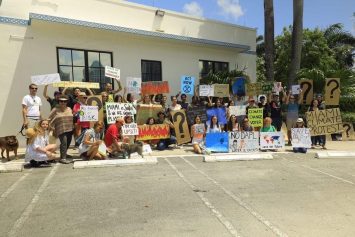
The author and youth activists participating in Fridays for Future – Climate Change Strike, May 2019
Since then, a few things have happened. Under pressure from youth activists, especially from CLEO, several local municipalities have announced climate emergencies. More school strikes have taken place. On Black Friday, students held a die-in to protest consumerism’s role in the climate crisis inside the city’s massive Dadeland Mall. A week later, protesters walked from the Government Center to Miami’s Torch of Friendship, where they unveiled a banner urging more local governments to declare a climate emergency.
After the strike, I rode my bike through the various Art Basel 2019 events on Miami Beach, visiting Xavier Cortada’s exhibit: Futurescape Miami – Skyline to Shoreline, where I learned about the artist’s latest project Plan(T); it invites residents to plant mangrove seedlings to sequester CO2 and increase the area covered by this saltwater-tolerant species (Cortada, 2019). I told the artist about my efforts to teach climate change facts to college students, and he encouraged me to take some of the informative pamphlets back to share with them. When I spotted some of the Underwater Homeowner Association’s yard signs that had been on display last year and told him that I had wanted to put an elevation marker in my yard for the longest time, Cortada graciously called over one of his assistants to help me pick one out. Now that I finally have my own sign, I can involve neighbors in conversations about the climate, too.
In 2020, I look forward to teaching my new students about the climate challenges we confront and exploring creative mitigation methods like the mangrove reforestation project that we can all get involved in. My fingers are crossed.
References
BBC News (2009, October 17). Maldives cabinet makes a splash. [Video file]. Retrieved from
http://news.bbc.co.uk/2/hi/8311838.stm
Bostick, K. W., Johnson, S. A., and Martin B. (2018). Florida’s geological history. University of Florida, Institute of Food and Agricultural Sciences (ResearchReport WEC 189). Retrieved from
https://edis.ifas.ufl.edu/pdffiles/UW/UW20800.pdf
Bould, A. (2017, April 1). April Fool! No, polar bears have not been spotted in Scotland. The Telegraph. Retrieved from
https://www.telegraph.co.uk/science/2017/04/01/april-fool-no-polar-bears-have-not-spotted-scotland/
Cortada, X. (2018). Underwater HOA. Retrieved from
https://cortadaprojects.org/underwaterhoa/
Cortada, X. (2019). Plan(T). Retrieved from
https://cortadaprojects.org/plant/
Englander, J. (2014). John Englander at TEDx Boca Raton: Sea level rise – fact & fiction.
[Video file]. Retrieved from
https://www.youtube.com/watch?v=TH8Q8Ki9fCA
Florida, R. (2018, July 5). ‘Climate gentrification’ will deepen urban inequality. CityLab.
Retrieved from
https://www.citylab.com/equity/2018/07/the-reality-of-climate-gentrification/564152/
Hahn, J. (2019, January/February). Sea change: South Florida races to respond to rising waters.
Sierra, 103(1), 36-41.
GIS Center Florida International University. (2019). Sea Level Rise App. Tool to determine elevation of an address and impact of sea level rise. Retrieved from
Goodell, J. (2017). The water will come: Rising seas, sinking cities, and the remaking of the
civilized world. New York: Little, Brown and Company.
Macintyre, P. and Bohlke, D., (2015). Reading explorer 4 (2nd ed.). Boston, MA: National
Geographic Learning – Cengage
McEntire, J., Pakenham, K. J., and Williams, J. (2013). Making connections 3: Skills and
Strategies for academic reading (3rd ed.). New York: Cambridge University Press.
NASA. (n.d.). Global Climate Change: Vital Signs of the Plante. Interactives. Retrieved from
https://climate.nasa.gov/interactives/climate-time-machine
NASA. (n.d.). Global Climate Change: Vital Signs of the Planet. Earth Minute Videos.
Retrieved from
https://climate.nasa.gov/climate_resource_center/earthminute
Sevigny, P. (2012). Extreme discussion circles: Preparing ESL students for “The Harkness
Method”. Polyglossia (23), 181-191. Retrieved from
The Earth Charter (2000). The Earth Charter Initiative. Retrieved from
http://earthcharter.org/discover/the-earth-charter/
Williams, J. (2016). 21st Century communication 2: Listening, speaking, and critical thinking.
Boston, MA: National Geographic Learning – Cengage Learning.







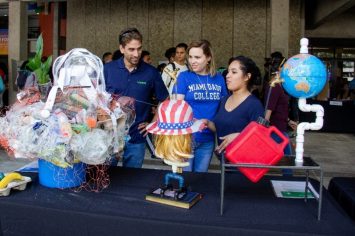

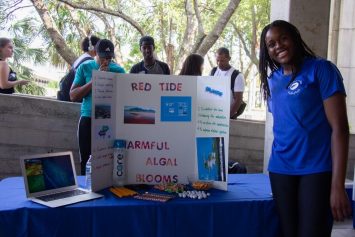
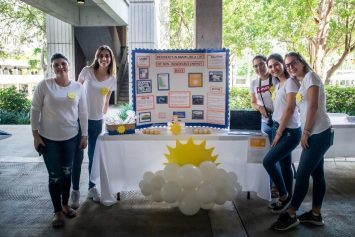
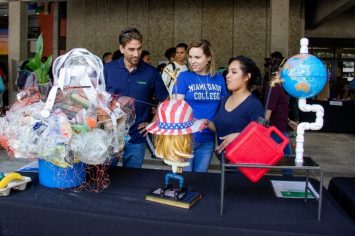
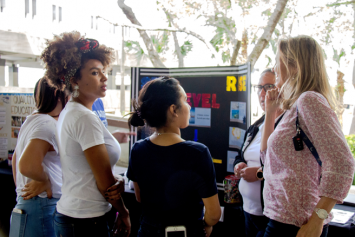
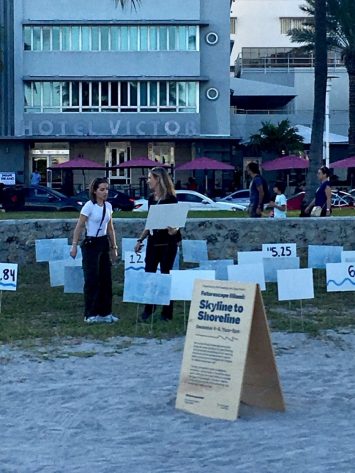



 Anouchka Rachelson, a native of Berlin, Germany, holds an Ed.D. in Higher Education, an M.S. in TESOL (Teaching English to Students of Other Languages), and a B.A. in English. She is a professor of World Languages at Miami Dade College, Florida, where she teaches English for Academic Purposes and facilitates professional development workshops in Earth Literacy and Sustainability Education. In 2015, she was awarded the Dr. Eduardo Padrón Endowed Teaching Chair. In addition to leading the Sustainability Committee at her campus, she also serves on the college’s Earth Ethics Institute Council. Most recently, Dr. Rachelson co-authored The Seven Competences of the Sustainable Professional with Dr. Niko Roorda (Routledge, 2018).
Anouchka Rachelson, a native of Berlin, Germany, holds an Ed.D. in Higher Education, an M.S. in TESOL (Teaching English to Students of Other Languages), and a B.A. in English. She is a professor of World Languages at Miami Dade College, Florida, where she teaches English for Academic Purposes and facilitates professional development workshops in Earth Literacy and Sustainability Education. In 2015, she was awarded the Dr. Eduardo Padrón Endowed Teaching Chair. In addition to leading the Sustainability Committee at her campus, she also serves on the college’s Earth Ethics Institute Council. Most recently, Dr. Rachelson co-authored The Seven Competences of the Sustainable Professional with Dr. Niko Roorda (Routledge, 2018). 
